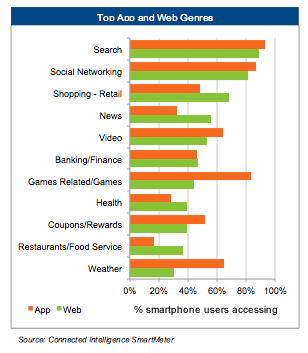The native apps versus mobile web technologies debate stems from the fact that while apps have become the de facto way for content owners, retailers, brands, and others to extend content experiences, drive commerce, and build brand and loyalty among mobile consumers - delivering consistent app experiences across multiple platforms/OS and device types can be daunting and costly.
While the mobile web, and more specifically HTML5, is certainly looked at as a means to bridge the app fragmentation gap, enable delivery of consistent content experiences, and address investment/cost considerations, the technology is not quite ready for primetime and mainstream adoption. This point has certainly been punctuated, as big brands, including Facebook and LinkedIn, have both retrenched in native apps. This does not mean that HTML5 is dead, just that it’s early.

Despite the fact that consumers are spending more and more of their disposable mobile time in apps, there are a number of smartphone behaviors where consumers are relying more heavily on mobile websites over apps, according to NPD’s Connected Intelligence June 2013 report “This is an App’s World: Can HTML5 Rejuvenate the Mobile Web?” This is certainly true for such activities as checking the news and visiting retail shopping websites; whereas clearly gaming is all about immersive app experiences. Interestingly, apps only have a slight lead over their mobile website counterparts in search and social networking activities. Despite Facebook’s continuous app enhancements/updates and more recent efforts to Facebook-ize the home screen (Facebook Home), smartphone users are just as inclined to visit the Facebook website as the Facebook app on their smartphones.
Clearly, consumers are speaking with their smartphone behaviors, so the mandate for content owners, brands, and retailers is that mobile product strategies need to pay attention to all mobile consumer touch points – websites and apps – and of course leveraging the most of these distinct assets’ capabilities.
To move the needle on HTML5, mobile web advocates need to focus on establishing and delivering on specifications and performance tools, and showcase compelling use cases for the technology and explore “hybrid apps.”
Native apps will rule for the foreseeable future, but regardless of platform retention is key. Native apps are where consumers are currently spending the vast majority of their time on their smartphones. But regardless of platform, companies need to focus on not just building cost-effective and compelling mobile solutions to meet consumer needs, but also on retention and stickiness for their mobile products, particularly in light of how much time, money, and effort they are spending on their mobile touch points.


